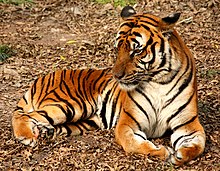Panthera tigris amoyensis
| South China tiger | |
|---|---|
 |
|
| Scientific classification | |
| Kingdom: | Animalia |
| Phylum: | Chordata |
| Class: | Mammalia |
| Order: | Carnivora |
| Family: | Felidae |
| Genus: | Panthera |
| Species: | P. tigris |
| Subspecies: | P. t. amoyensis |
| Trinomial name | |
|
Panthera tigris amoyensis (Hilzheimer, 1905) |
|
 |
|
| South China Tiger natural habitat (black) | |
The South China tiger (Panthera tigris amoyensis) is a tiger subspecies that was native to the provinces of Fujian, Guangdong, Hunan, Jiangxi in southern China, and has been listed as Critically Endangered on the IUCN Red List since 1996. It is possibly extinct in the wild since no wild individual has been recorded since the early 1970s. Already in the late 1990s, continued survival was considered unlikely due to low prey density, widespread habitat degradation and fragmentation, and other human pressures.
Since the 1980s, the South China tiger is considered a relict population of the "stem" tiger, living close to the possible area of origin. Morphologically, it is the most distinctive of all tiger subspecies. Results of a phylogeographic study indicate that southern China and northern Indochina was likely the center of the tiger radiation.
The name Amoy tiger was used in the fur trade. It is also known as the South Chinese, the Chinese, and the Xiamen tiger.
In 1905, the German zoologist Max Hilzheimer first described the South China tiger as similar in height to the Bengal tiger, but differing in skull and coat characteristics. Their carnassials and molars are shorter than in his Bengal tiger samples; the cranial region is shorter with orbits set closer together, postorbital processes are larger. Their coat is lighter and more yellowish and the paws, face, and stomach appear more white; the stripes are narrower, more numerous and more sharp-edged.
...
Wikipedia

